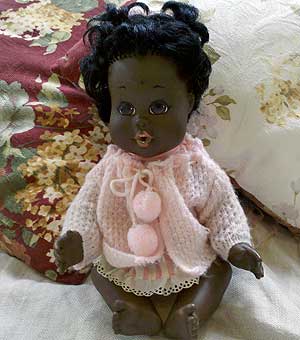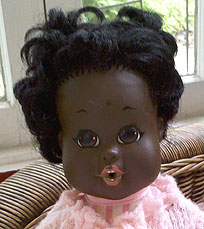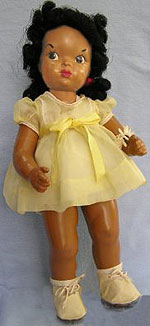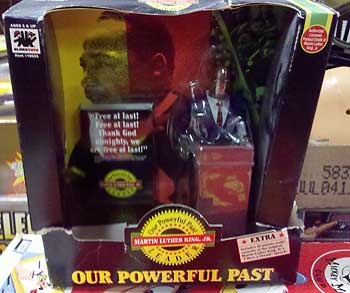I had seen the big box of dolls several times at the auction house and had rifled through it a few times. I was looking but not seeing. No one else seemed to be interested in them, either.
Most of them were stuffed dolls – one was a knock-off black Cabbage Patch and another was a Dennis the Menace. A few were vinyl dolls from the 1970s.
Finally, at a recent auction, I decided to take my time to actually check the dolls’ necks for the makers’ names. I ignored the soft dolls and picked up a small black vinyl doll whose face looked as if it had been squished.

Some of the color had worn off her lips but the doll seemed to be in good condition, with her dark-chocolate skin, and happy and expressive face. She was a small doll, no more than 13 inches tall, with jointed legs that allowed her to sit. On her neck was inscribed: “Div. of Operation Bootstrap, Inc. USA. 1968. Shindana.”
That was a new name for me. It was not the usual Ideal or Madame Alexander or Effanbee. Now, I was curious. I intentionally did not ask that the doll be put up for bids separately for fear that another bidder would suddenly be interested and hike the price. So, I bought the entire lot of about a dozen dolls for $5.
I researched the doll and found that Baby Nancy was manufactured by a black toy company called Shindana Toys in 1968. The company grew out of the 1965 Watts riots that devastated South Central Los Angeles, and its aim was to help rebuild the neighborhood, where it was located.

It was a community-based company founded by Louis S. Smith II and Robert Hall, with financial backing from Chase Manhattan Capital Corp., the Mattel Toy Co. and other companies, according to one account. A Chase Manhattan ad from 1972 noted that the black-owned Bank of Finance in Los Angeles also helped put together the company’s financial package.
Baby Nancy was sold for around $5 to $6 at Sears, Montgomery Ward, JC Penney, Woolworth and W.T. Grant. The doll seemed to have been an instant hit and sold exceedingly well.
I didn’t find that very surprising, since it was the first mass-produced doll that actually looked like little black girls. As far back as the 1800s, German and French doll companies had made black dolls, primarily by painting the molds they had used for their white dolls. That meant the dolls had white features and not their own natural look.

American doll companies continued the trend, with composition dolls in the early part of the 20th century, and then vinyl and rubber dolls. African American cartoonist Jackie Ormes contracted with the Terri Lee company to make a doll based on her girl character Patty Jo. The company had made a black doll named Bonnie Lou and re-created her for the Ormes project, according to the Philadelphia Doll Museum website.
It was not until the 1960s that black dolls changed their looks at the hands of black toy-makers – the first being Beatrice Wright who formed B. Wright Toy Co. Several dolls bearing her company’s inscription are said to have a copyright year of 1967 on their bodies.
Other black doll companies included Whitney Doll Inc., Golden Ribbon Playthings and Olmec Inc. I found two companies with the name Keisha. The Keisha Doll Co. of New York, according to a 1987 New York Times story, made black dolls in various skin tones, with some in African dress with cornrows or beaded hair. The other company was based in Jacksonville, FL, and made Cleopatra, Shaka Zulu and princess dolls.

Here’s a 1975 ad for Toys R Us featuring black and white dolls, all of which are identical except for the Jimmy “JJ” Walker stuffed doll by Shindana.
The Shindana company seemed to have been around until the early 1980s. Baby Nancy was followed by other dolls, including a collection called Little Friends consisting of African American, white, Asian and Hispanic boy and girl dolls. All of its dolls seemed to be talkers (Tamu seemed to speak a lot of phrases), and some were soft-bodied and celebrity lookalikes: Redd Fox, JJ, Flip Wilson (with Geraldine on the reverse side), Marla Gibbs, Dr. J., O.J. Simpson and the super agent Slade.
Kim appeared to be its fashion doll that came with clothes. And there was Baby Zuri.
Today, you can find any manner of black dolls with natural features, a far cry from way back when.

